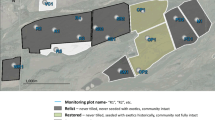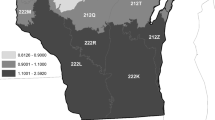Abstract
Extensive logging in the twentieth century destroyed much of the coniferous forests in the lower Redwood Creek basin of Redwood National Park. Restoration of cutover lands requires the identification of historical, pre-logging reference conditions. Field notes from the original Public Land Surveys were used to reconstruct the pre-EuroAmerican settlement forests. Most reconstructive studies based on historic surveys rely on bearing tree evidence over large areas to determine vegetation patterns over several hundreds to thousands of square kilometers. Due to the small size of the study area (approximately 200 km2), bearing tree evidence could not accurately reconstruct the vegetation at this scale. Instead, lists of the overstory and understory vegetation for each surveyed mile (line summaries) were employed. Analysis of line summaries evidence identified the historical importance, geographical range, and environmental influences on woody species and vegetation communities. Topography, especially elevation, and soil texture were significantly correlated with plot-scale ordination scores derived from non-metric multidimensional scaling. The influence of topography and distance to ocean coast on the historical distribution of dominant woody species concurs with findings from present-day field studies of local and regional old-growth forest. A comparison with present-day vegetation maps revealed that coast redwood (Sequoia sempervirens), Douglas fir (Pseudotsuga menziesii), Sitka spruce (Picea sitchensis), and red alder (Alnus rubra) experienced the most substantive changes in the vegetation as a result of twentieth century land use activities.






Similar content being viewed by others
References
Abrams MD (2001) Eastern white pine versatility in the presettlement forest. Bioscience 51(11):967–979. doi:10.1641/0006-3568(2001)051[0967:EWPVIT]2.0.CO;2
Almendinger JC (1997) Minnesota’s bearing tree database. Natural heritage information system. Section of Ecological Services, Division of Fish and Wildlife, Minnesota Department of Natural Resources, Minnesota
Best DW (1995) History of timber harvest in the Redwood Creek basin, northwestern California. U.S. geological survey professional paper 1454-C. In: Nolan KM, Kelsey HM, Marron DC (eds) Geomorphic processes and aquatic habitat in the Redwood Creek basin, northwestern California. U.S. Government Printing Office, Washington, DC, pp C1–C7
Biringer J, Hansen LJ (2005) Restoring forest landscapes in the face of climate change. In: Mansourian S, Vallauri D, Dudley N (eds) Forest restoration in landscapes: beyond planting trees. Springer, New York, pp 31–37
Bollinger J, Schulte LA, Burrows SN, Sickley TA, Mladenoff DJ (2004) Assessing ecological restoration potentials of Wisconsin (U.S.A.) using historical landscapes reconstruction. Restor Ecol 12(1):124–142. doi:10.1111/j.1526-100X.2004.00285.x
Burns RM, Honkala BH (tech coords) (1990) Silvics of North America, vol 1: conifers, vol 2: Hardwoods, Agriculture Handbook 654, Forest Service, U.S. Department of Agriculture, Washington, DC. http://www.na.fs.fed.us/pubs/silvics_manual/table_of_contents.shtm. Accessed 09 Mar 2009
Busing RT, Fujimori T (2002) Dynamics of composition and structure in an old Sequoia sempervirens forest. J Veg Sci 13(6):785–792
Calflora: Information on California Plants for Education, Research and Conservation (2006) Pseudotsuga menziesii (Mirbel) Franco var. menziesii, Taxon report 6907. The Calflora Database, Berkeley, California. http://www.calflora.org/. Accessed 18 Mar 2009
California Environmental Resources Evaluation System (CERES) (1997) Digital elevation model (30 m). Teale GIS Solutions Group, California Environmental Resources Evaluation System, California. http://gis.ca.gov/casil/gis.ca.gov/dem/. Accessed 18 Mar 2009
Chase AW (1874) Timber belts of the Pacific coast. Overl Mon Out W Mag 13(3):242–249
Cogbill CV, Burk J, Motzkin G (2002) The forests of presettlement New England, U.S.A.: spatial and compositional patterns based on town proprietor surveys. J Biogeogr 29:1279–1304. doi:10.1046/j.1365-2699.2002.00757.x
Collins BD, Montgomery DR, Sheikh AJ (2003) Reconstructing the historical riverine landscape of the Puget Sound Lowland. In: Montgomery DR, Bolton S, Booth DB, Wall L (eds) Restoration of Puget sound rivers. University of Washington Press, Seattle, pp 79–128
Daly C, Taylor G (1998) Klamath network average annual precipitation, 1961-90. Water and climate center of the natural resources conservation service, Portland, Oregon. http://science.nature.nps.gov/nrdata/datastore.cfm?ID=37483. Accessed 24 Feb 2007
Davey CA, Redmond KT, Simeral DB (2007) Weather and climate inventory, National Park Service Klamath Network. Natural Resource Technical Report NPS/KLMN/NRTR—2007/035, WRCC Report 2007-10. Natural Resource Program Center, National Park Service, U.S. Department of Interior, Fort Collins, Colorado
Egan D, Howell EA (2005) Introduction. In: Egan D, Howell EA (eds) The historical ecology handbook: a restorationist guide to reference ecosystem. Island Press, Washington, DC, pp 1–23
Environmental Protection Agency (EPA) (1998) Redwood creek sediment total maximum daily load. Water Division, Region 9, U.S. Environmental Protection Agency
ESRI (2005) ArcMap 9.1. Environmental Systems Research Institute, Redlands
Fritschle JA (2007) An intermediate-scale reconstruction of historic vegetation in Redwood National Park using the Public Land Survey. Dissertation, University of Wisconsin-Madison
Fritschle JA (2008) Reconstructing historic ecotones using the Public Land Survey: the lost prairies of Redwood National Park. Ann Assoc Am Geogr 98(1):24–39. doi:10.1080/00045600701734018
Greene LW (1980) Historical overview of the Redwood Creek Basin and Bald Hills regions of Redwood National Park, California. National Park Service, U.S. Department of the Interior, Denver
Grimm EC (1984) Fire and other factors controlling the big woods vegetation of Minnesota in the mid-nineteenth century. Ecol Monogr 54(3):291–311. doi:10.2307/1942499
Harris JA, Hobbs RJ, Higgs E, Aronson J (2006) Ecological restoration and global climate change. Restor Ecol 14(2):170–176. doi:10.1111/j.1526-100X.2006.00136.x
Kent M, Coker P (1992) Vegetation description and analysis: a practical approach. CRC Press, Ann Arbor
Lenihan JM (1990) Forest associations of Little Lost Man Creek, Humboldt County, California: reference-level in the hierarchical structure of old-growth coastal redwood vegetation. Madrono 37(2):69–87
Lenihan JM, Bachelet D, Neilson RP, Drapek R (2008) Response of vegetation distribution, ecosystem productivity, and fire to climate change scenarios for California. Clim Change 87(suppl 1):S215–S230. doi:10.1007/s10584-007-9362-0
Little EL (1994) National Audubon society field guide to North American trees, western region. Alfred A. Knopf, New York
Mahony TM, Stuart JD (2000) Old-growth forest associations in the northern range of coastal redwood. Madrono 47(1):53–60
Mahony TM, Stuart JD (2007) Status of vegetation classification in redwood ecosystems. In: Standiford RB, Giusti GA, Valachovic Y, Zielinski WJ, Furniss MJ (eds) Proceedings of the redwood region forest science symposium: what does the future hold? General technical report PSW-GTR-194. Pacific Southwest Research Station, Forest Service, US Department of Agriculture, Albany, pp 207–214
Manies KL, Mladenoff DJ (2000) Testing methods to produce landscape-scale presettlement vegetation maps from the U.S. Public Land Survey records. Landscape Ecol 15:741–754. doi:10.1023/A:1008115200471
Manies KL, Mladenoff DJ, Nordheim EV (2001) Assessing large-scale surveyor variability in the historic forest data of the original U.S. Public Land Survey. Can J For Res 31:1719–1730. doi:10.1139/cjfr-31-10-1719
McCune B, Grace JB (2002) Analysis of ecological communities. MjM Software Design, Gleneden Beach, Oregon
McCune B, Keon D (2002) Equations for potential annual direct incident radiation and heat load. J Veg Sci 13:603–606
McCune B, Mefford MJ (1999) PC-ORD, Multivariate analysis of ecological data, version 5.0. MjM Software, Gleneden Beach, Oregon
Muldavin EH, Lenihan JM, Lennox WS, Veirs SD (1981) Vegetation succession in the first 10 years following logging of the coast redwood forests. Redwood National Park technical report no. 6. National Park Service, U.S. Department of the Interior, Arcata, California
Natural Resources Conservation Service (NRCS) (2007) Partial soil survey geographic (SSURGO) database for Humboldt and Del Norte Area, California. U.S. Department of Agriculture, Fort Worth, Texas. http://SoilDataMart.nrcs.usda.gov/. Accessed 18 Mar 2009
Redwood National Park (RNP) (1996) Checklist of the vascular plants of Redwood National Park. Species in parks, flora and fauna database, online query system. Information Center for the Environment, University of California, Davis, and National Park Service, Davis, California. http://ice.ucdavis.edu/nps/sbypark.html. Accessed 12 July 2006
Redwood National and State Parks (RNSP) (2000) General management plan, Redwood National and State Parks, Humboldt and Del Norte Counties, California. National Park Service, U.S. Department of the Interior, California Department of Parks and Recreation, Denver Service Center, Colorado
Redwood National and State Parks (RNSP) (2008) Fact sheet. Redwood Park Association, National Park Service, U.S. Department of the Interior, California Department of Parks and Recreation, Redwood National and State Parks, California. http://www.nps.gov/redw/planyourvisit/brochures.htm#CP_JUMP_134687. Accessed 18 Mar 2009
Remote Sensing Lab (2004) Vegetation Classification, Vegetation Descriptions, North Coast and Montane Ecological Province—CALVEG Zone 1. Pacific Southwest Region, Forest Service, U.S. Department of Agriculture. http://www.fs.fed.us/r5/rsl/projects/classification/ncoast-veg-descript.shtml. Accessed 18 Mar 2009
Remote Sensing Lab (2005) FSSDE.EvegTile01A/B (vector digital data), 1:100,000. Pacific Southwest Region, Forest Service, U.S. Department of Agriculture, McClellan, California. http://www.fs.fed.us/r5/rsl/clearinghouse/aa-ref-sec263a.shtml. Accessed 18 Mar 2009
Russell WH, Jones C (2001) The effects of timber harvesting on the structure and composition of adjacent old-growth coast redwood forest, California, USA. Landscape Ecol 16:731–741. doi:10.1023/A:1014486030462
Sawyer JO, Gray J, West GJ, Thornburgh DA, Noss RF, Engbeck JH Jr, Marcot BG, Raymond R (2000a) History of redwood and redwood forests. In: Noss RF (ed) The redwood forest: history, ecology and conservation of the coast redwoods. Island Press, Washington, DC, pp 7–38
Sawyer JO, Sillett SC, Popenoe JH, LaBanca A, Scholars T, Largent DL, Euphrat F, Noss RF, Van Pelt R (2000b) Characteristics of redwood forests. In: Noss RF (ed) The redwood forest: history, ecology and conservation of the coast redwoods. Island Press, Washington, DC, pp 39–80
Schulte LA, Mladenoff DJ (2001) The original US Public Land Survey Records: their use and limitations in reconstructing presettlement vegetation. J For 99:5–10
Scull P, Richardson JL (2007) A method to use ranked timber observations to perform forest composition reconstructions from land survey data. Am Midl Nat 158:446–460. doi:10.1674/0003-0031(2007)158[446:AMTURT]2.0.CO;2
Seischab FK (1990) Presettlement forests of the Phelps and Gorham Purchase in western New York. Bull Torrey Bot Club 117:27–38. doi:10.2307/2997126
Seischab FK (1992) Forests of the Holland Land company in western New York, circa 1798. In: Marks PL, Gardescu S, Seischab FK (eds) Late eighteenth century vegetation of central and western New York State on the basis of original land survey records, New York State Museum Bulletin, New York State Museum. University of the State of New York, Albany, pp 36–53
Society for Ecological Restoration Science & Policy Working Group (SER) (2004) The SER International primer on ecological restoration, version 2. http://www.ser.org/content/ecological_restoration_primer.asp. Accessed 18 Mar 2009
Stewart LO (1935) Public land surveys: history, instructions, methods. Arno Press Inc, New York
Tart D, Williams C, DiBenedetto J, Crowe E, Girard M, Gordon H, Sleavin K, Manning M, Haglund J, Short B, Wheeler D (2005) Sect. 2: existing vegetation classification protocol. In: Brohman R and Bryant L (eds) Existing vegetation classification and mapping technical guide, Gen. Tech. Rep. WO–67, Ecosystem Management Coordination Staff, Forest Service, U.S. Department of Agriculture, Washington, D.C., pp. 2.1–2.34
U.S. Fish and Wildlife Service (1997) Recovery plan for the marbled murrelet (Brachyramphus marmoratus) in Washington, Oregon and California. U.S. Fish and Wildlife Service, Portland
Uzes FD (1977) Chaining the land: a history of surveying in California. Landmark Enterprises, Sacramento
Veirs SD (1982) Coast redwood forest: stand dynamics, successional status, and the role of fire. In: Means JE (ed) Forest succession and stand development research in the northwest. Forest Research Laboratory, Oregon State University, Corvallis, pp 119–141
Veirs SD (1986) Redwood second-growth forest stand rehabilitation study, Redwood National Park: evaluation of 1978–79 thinning experiments. Redwood National Park, Orick, California
Veirs SD, Lennox WS (1981) Rehabilitation and long-term management of cutover redwood forests: problems of natural succession. Symposium of Watershed Rehabilitation in Redwood National Park and Other Pacific Coastal Areas, Redwood National Park Archives, Arcata, California
Wang Y (2005) Presettlement land survey records of vegetation: geographic characteristics, quality and modes of analysis. Prog Phys Geogr 29(4):568–598. doi:10.1191/0309133305pp463ra
Waring RH, Major J (1964) Vegetation of the California coastal redwood region in relation to gradients of moisture, nutrients, light, and temperature. Ecol Monogr 34(2):167–215. doi:10.2307/1948452
White CA (1984) A history of the rectangular survey system. Bureau of Land Management, Government Printing Office, Washington, DC
Acknowledgments
I would like to thank Ted Sickley for assistance in GIS data preparation and Stephen Veirs for guidance in the formative stages of the project. I am also grateful to Tom Vale, Matt Turner, Caroline Fritschle, Joan Welch, and the anonymous reviewers for their constructive comments on the manuscript.
Author information
Authors and Affiliations
Corresponding author
Rights and permissions
About this article
Cite this article
Fritschle, J.A. Pre-EuroAmerican settlement forests in Redwood National Park, California, USA: a reconstruction using line summaries in historic land surveys. Landscape Ecol 24, 833–847 (2009). https://doi.org/10.1007/s10980-009-9361-9
Received:
Accepted:
Published:
Issue Date:
DOI: https://doi.org/10.1007/s10980-009-9361-9




